Abstract
The present work aims to develop a digital twin system typical of intelligent manufacturing applications, which has integrated visualization technologies, as well as the process parameter simulation solution. The application under consideration is a typical machining process, with a gantry machine tool controlled by Siemens Programmable Logic Controller(PLC) S7-1200. With the establishment of dual-directional data communication between the physical machine tool and its virtual counterpart based on TCP/IP protocol, real-time visualization, monitoring, and control of the entire working process can be achieved. Furthermore, we integrated with the digital twin system as a solution for real-time process parameter simulation based on finite element modeling (FEM), which enables the real-time monitoring of necessary process parameters, e.g., surface deformation, during the machining process. A preliminary experiment was conducted to validate our proposed digital twin system, and the results demonstrated that our proposed method has satisfactory performance in terms of both control and monitoring of the traditional machining process, and synchronization between the physical and virtual models is also proven to be positive with minimal latency.
1. Introduction
In light of the ongoing advancements in information and internet technology, it has become increasingly evident that the production capacity and efficiency of traditional manufacturing sectors struggle to align with the demands of technological and societal progress. This predicament necessitates a fundamental reassessment of traditional manufacturing industries, compelling them to seek innovative strategies and pivotal transformations. Specifically, this calls for a strategic shift toward intelligent manufacturing to meet the multifaceted imperatives of contemporary technological and societal advancement. To actualize intelligent manufacturing, substantial efforts have been undertaken in both academic and industrial spheres, encompassing burgeoning technological domains such as big data analytics, the industrial Internet of Things (IoT), cloud computing infrastructure, artificial intelligence (AI), and blockchain technology.
Notably, there has been a significant enhancement in the integration and precision of emblematic complex equipment like drones, satellites, and industrial robots. This enhancement has led to a substantial increase in the overall lifecycle cost of designing, developing, testing, operating, and maintaining these complex systems. Simultaneously, the heightened complexity of these devices significantly escalates the demand for accuracy in status monitoring. Consequently, monitoring, evaluating, and predicting the operational status of complex equipment have become prominent focuses of academic research [1].
Amidst this backdrop, digital twin (DT) technology emerges as a pivotal facilitator and a tangible bridge toward realizing the paradigm of intelligent manufacturing. It harbors profound potential for effectively addressing the intricate challenge of harmonizing information and physical integration within the complex fabric of intelligent manufacturing. Consequently, digital twin technology has garnered sustained attention from scholars actively engaged in both academic exploration and practical application, particularly in the context of resolving multifaceted engineering problems. For instance, Grieves et al. [2] introduced a novel concept of a digital twin factory’s process model, illustrating a profound link between the practical physical world and the virtual information world, marking an undeniable trend toward intelligence. Esteemed scholars in this domain, exemplified by Yu et al. [3], emphasized the transformative potential of digital twins within the context of cyberphysical systems. Digital twins represent a novel technological paradigm that introduces innovative approaches to enhance decision-making processes in product development and process design. Leveraging entity models and digital twin models, the application of digital twin technology has enabled real-time data monitoring, providing precise descriptions and rapid responses to dynamic states of various production variables. This advancement has significantly improved the real-time and predictive capabilities of process decision-making technology. Additionally, Guo et al. [4] underscored the comprehensive nature of digital twins, seamlessly integrating virtual representations with tangible production conditions, supported by copious real-time data derived from physical models. This integration facilitates the construction of a process twin model that faithfully mirrors the real-world operational environment. Through meticulous simulation, analysis, and real-time process monitoring, this approach culminates in a closed-loop optimization of process design outcomes.
Although currently available digital twins technology facilitates factory equipment monitoring and mapping into respective virtual models, state-of-the-art technology and existing work mostly appear limited to the monitoring of the processing equipment itself, specifically involving real-time surveillance of its posture and movements. As articulated by Fei Tao et al. [5], despite introducing concepts like “physical workshop heterogeneous element fusion” or “physical fusion”, issues persist in achieving complete interconnectivity of heterogeneous elements. One such challenge arises from integrating data originating from the actual process execution device with data from the processed entity to achieve a precise and comprehensive digital twin model. The absence of comprehensive modeling and information obtained from the processed object precludes the simultaneous monitoring thereof. Consequently, the industrial facility encounters a challenge in achieving concurrent real-time monitoring of both the processing equipment and the targets, thus impeding the construction of a holistic digital twin for the complete processing procedure. This limitation is particularly significant when determining certain process parameters, as the real-time impact of current parameters on the processed entity remains imperceptible. An example is evident in the execution of a rudimentary extrusion process, where the monitoring of the deformation of the object under the current load is unattainable. Despite these inherent limitations, the study makes noteworthy strides by partially realizing real-time monitoring of the processed object. It accomplishes this by integrating the digital twin of the processing equipment with that of the processed object, drawing data for digital twin instantiation from the amalgamation of processing equipment data, and simulation predictions for the processed object. The present study is based on a classic case study in industrial applications, specifically, the machining process, which involves various uncertainties and numerous process parameters. Consequently, the study aims to develop a digital twin (DT) system for a small-scale milling machine workstation, which can enable the optimization of production processes, thus enhancing the efficiency of process decision making within the realm of digital twin applications. The study-developed DT system integrates data from processing equipment (i.e., the milling machine) and also various process parameters from processed entities (i.e., the workpiece). With such a DT system, users can monitor the status of processed entities during processing while obtaining real-time information about the processing equipment, enabling optimization of the machining process. This integrative study holds promise in furnishing more expansive and accurate information for the application of DTs within the domain of industrial process design. Consequently, it serves to advance the optimization of machining processes and enhance the efficacy of process decision making.
The paper is organized as follows: the state-of-art work related to the development of digital twin technology, especially in the context of industrial applications, is reviewed in Section 2. Section 3 describes the configuration of our proposed DT system and our approach to system development. The experiments conducted and results obtained for evaluating the performance of our developed DT system are presented in Section 4, where a detailed discussion of available results is also presented. Limitations of our developed DT system and suggestions for future improvements are discussed in Section 5. Section 6 concludes the present study, while highlighting the industrial implications and directions relevant further developments.
2. Related Work
DT technology has made significant strides in industrial applications, driving the evolution of Industry 4.0 and, most recently, Industry 5.0. These technologies have been harnessed to improve efficiency, productivity, and decision-making processes across different sectors. Much work has been carried out to explore applications of DTs to promote intelligence of industrial equipment, facilities, systems, etc., and, especially, various production systems in intelligent manufacturing, shedding light on its current uses.
Of the work focusing on DT technology in manufacturing applications, Balla et al. [6] reported two case studies, both developing DT platforms for typical production systems in manufacturing, i.e., an assembly line and a warehouse stacker. The physical platforms of both systems are driven by the Simens PLC, which is the most popular controller in industrial applications. This work successfully developed effective communication between the Simens PLC and the interface of the DT virtual model developed in Unity, by employing Game4Automation and Fishertechnik models. The case studies of manufacturing systems and the developed DT platforms are primarily used for educational purposes in engineering courses, in which they characterize the state-of-the-art DT technology in the context of Industry 4.0. More importantly, they have provided confidence and solutions to establish direct communication between the Unity-developed DT system and the PLC-controlled systems. For the work of developing DT systems for PLC-controlled manufacturing systems, apart from [6], Yang et al. [7] developed the DT for a crane typically used on factory shop floors, while communication in between the physical crane and its DT, again developed in Unity, is established by applying the OPC UA [8] technology. Furthermore, they integrated with their DY the VR/AR technology. Similar work was reported by Minca et al. [9], which also applied OPC UA for communication in between a physical assembly line controlled by the Siemens PLC system and its DT counterpart. The work of [6,7,8,9] provided a solution for communication issues with DT platforms which involves PLC control, yet they either introduced dedicated, chargeable, plug-ins (e.g., Game4Automation) or hardware components (since OPC UA requires additional hardware communication components and authority of dedicated protocol); thus, the solutions are not widely applicable and are also expensive.
In the manufacturing domain, DT technology has actually been widely adopted in all types of manufacturing and production systems, such as robot arms, apart from those PLC controlled facilities. For instance, DT has been applied for online/remote programming of robot work cells [10,11], enabling trajectory replication with minimal latency. The work reported in [12] highlights the application of DT technology in modern manufacturing enterprises. AVEVA Wonderware software [13], as a tool for realizing the concept of digital twins, aims to create virtual representations of production systems, emphasizing the importance of establishing digital twins to support accuracy in manufacturing decision making. On the other hand, digital twins have also found applications in operator training within the Industry 4.0 environment. Fallaha, M. et al. [14] use virtual reality models for factory settings allows participants to virtually interact with machines, demonstrating the multifunctionality of digital twins in enhancing workforce training and skill development.
As the DT concept, with its relevant technology, further develops, it will have a significant impact on the existing and future industrial landscape. It can build a bridge between the real world and the virtual world. This integration enhances transparency, efficiency, and problem solving in industrial environments. For example, the study reported in [15] shows that creating a complete DT system for production lines enables machines to perform routine inspections without stopping while identifying any faulty parts. Meanwhile, DT systems can facilitate real-time analysis of manufacturing processes; as Hauge et al. [16] show the role of digital twins in providing insight into errors and inefficiencies on production lines, thus reshaping the way manufacturers manage their operations.
Furthermore, as illustrated in the study of [17], the digital twin approach is applicable to assembly systems and quality control. The real-time synchronization of data from the assembly system to the digital twin model highlights the potential for ongoing optimization without disrupting production. Such adaptability is essential for staying competitive in evolving industrial landscapes.
Despite significant development of DT technology and its wide application over the past decade, it appears the currently available DT technology cannot handle the problem of real-time monitoring of manufacturing process parameters, especially those for part fabrication applications, e.g., machining. Of the very limited work carried out in this respect, Lai et al. [18] attempted to integrate into their DT system an approach to monitor the real-time stress and strain variation, i.e., characterizing its deformation, of a boom crane subject to lifting heavy loads, to prevent it from failure due to overload. The real-time deformation data are obtained through finite element modeling (FEM) approach, which is integrated into their DT system. The application scenario is much simpler than the machining process and, thus, it is unsure whether the same approach is applicable. However, inspired by this work, we will make an attempt to adopt this approach in obtaining and monitoring machining process parameters, i.e., those characterizing deformation variation of a workpiece during the machining process. The remainder of this paper will detail our study and the outcomes.
3. Construction of Our Digital Twin System
The present study aims to explore the further application of digital twins in intelligent manufacturing, typically for machining processes to obtain and monitor process parameters in a real-time manner, which is not actually considered with currently available relevant technology. Therefore, we attempted to develop a digital twin system, based on a small-scale milling station, which can specifically achieve real-time monitoring in machining process parameters, i.e., stress and strain variation on the milling surface of the workpiece. We believe this is crucial to ensure the quality of the milling surface, as the data obtained can be used as inputs for optimum control of the milling process. The real-time data of stress and strain are obtained by integrating with our developed DT system the finite element modeling approach, which calculates the relevant data in a real-time manner. This section details the framework, and also every single component, of our developed DT system.
3.1. The Framework of Our Developed Digital Twin System
This paper presents a prototype designed to assess the feasibility and applicability of the proposed technical solution. Our developed DT system consists of three fundamental components: the design of the physical twin (i.e., the hardware milling station), the virtual twin (the virtual model of the milling station), and the FEM-based computer simulation module for obtaining real-time variation of stress and strain. The framework of the whole system is shown in Figure 1.
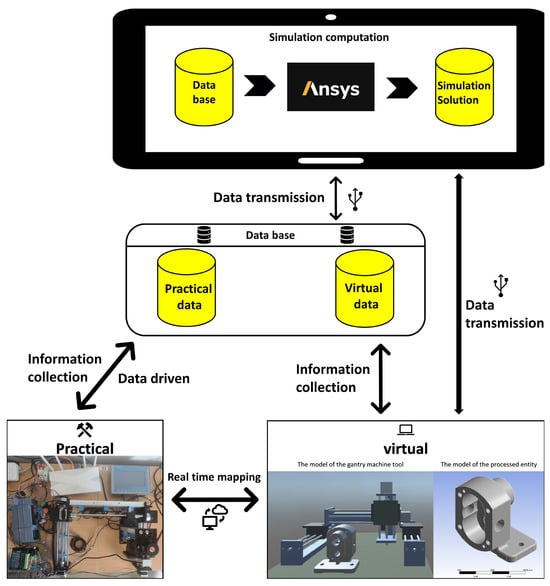
Figure 1.
The framework of our developed digital twin system.
First of all, the DT system can conduct real-time control and monitoring of the motion sequence of the milling station which is basically a three-axis gantry machine. For real-time control, our virtual twin is integrated with a graphic user interface (GUI), where the user can input motion commands which are sent to the machine controller (i.e., the Siemens S7-1200 PLC) and, subsequently, drive the coordinated motion of the three axes. During the operation of the physical machine, the real-time motion parameters of each axis are measured by the rotary encoder, which is sent to the virtual twin that drives the synchronous motion of the virtual model, with the relevant data also displayed on the GUI; hence, the real-time monitoring is achieved. The real-time monitoring overlooks not only that there is no malfunction in the motion behavior of the physical machine, but also the motion accuracy in estimating the deviation between the command (expected) and actual motion parameters.
Apart from real-time monitoring, control, and synchronization of axis motion sequence, the machining process parameters, especially the stress/strain variation, can be monitored in a real-time manner. Real-time variation of stress and strain on the surface (of a workpiece) being processed are calculated by a solver, based on FEM approach, which is implemented in ANSYS workbench [19]. The input of the FEM-based mathematical model, i.e., the real-time variation of the applied milling force, is obtained from the force sensor (parallel beam pressure sensor with a maximum range of 100 kg) and stored in the control PLC which is, then, transmitted to the database and subsequently accessed by the ANSYS FEM solver. Hence, the real-time deformation of the milling surface, characterized by the process parameters stress and strain, can be monitored.
To verify the validity of our FEM solver, as well as the accuracy of obtained stress/strain data, we physically measured the real-time strain variation over the milling surface using a laser range finder, which is then compared with our FEM simulated results (such comparison and verification are presented in Section 4.2).
In selecting the platform for the creation of the virtual interface in this study, Unity 3D was chosen, considering its renowned user-friendly interface. Unity is designed to be a cross-platform game engine that allows for flexibility in deploying applications across different operating systems and devices. This is particularly advantageous if the digital twin system needs to run on diverse hardware configurations, in contrast to Unreal engine. In addition, the choice of Unity for data transmission via the TCP socket protocol suite might be influenced by the ease with which Unity facilitates networking and communication between different components of the digital twin [20].
3.2. The Physical Twin
The physical twin stands for the hardware platform of the actual milling station, as shown in the bottom left of Figure 1. Detailed views showing the configuration of this milling station are shown in Figure 2.
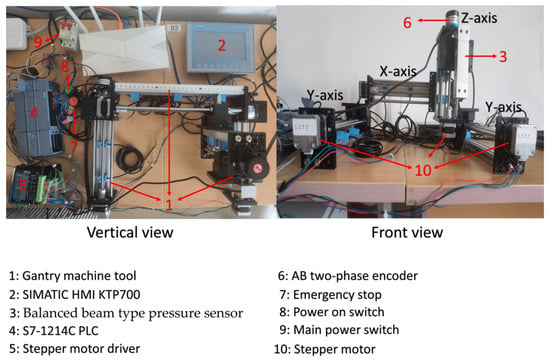
Figure 2.
Configuration of the physical twin, i.e., the small-scale milling machine, used in the present study.
In the present study, we considered a small-scale milling machine, which is a mock-up of the actual machine in a real industrial scenario, and this is due to the constraints of our experimental condition, e.g., budget constraints, space constraints, the policy restrictions in the laboratories that do not allow us to carry out metallic processing, etc. Nevertheless, within the permissible experimental conditions, we attempted to reproduce, as closely as possible, the real industrial scenario, despite the simplifications introduced, i.e., we extensively used industrial devices including PLC-based control systems, industrial actuators, sensors, etc.
As shown in Figure 2, our small milling machine has the gantry configuration, enabling the end tool (i.e., end effector) having linear motion in three directions, i.e., x, y, and z axes. Such linear motion in each axis is realized using lead-screw transmission modules driven by stepper motors. The lead of the screw shaft is 2 mm/rev, meaning a linear displacement of 2 mm for each revolution made by the stepper motor.
Primarily, the physical twin pertains to a corporeal apparatus employed for the direct execution of a designated process. This component assumes responsibility for pragmatic operations, encompassing material processing and morphological alterations, thereby furnishing authentic data to underpin the experimentation. Instead of one hundred percent reproducing the real industrial scenario, we did introduce simplifications but tried our best to remain as close as possible to the real industrial applications, e.g., used the PLC-based control system, and also as many industrial actuators and sensors, etc., as we can within the constraints of our experimental conditions. Upon confirmation of the applicability of our approach, as reported in this paper, the immediate future work will consider applying our approach in real scenarios, and we will try to find a way to completely reproduce the real industrial cases.
For the control system, the Siemens Programmable Logic Controller (PLC), version S7-1214C, was used to control the axis motion and machining process. The Siemens S7-1200 is a compact PLC which is widely applied in small- and medium-scale industrial automated systems, and is particularly suitable in most basic control applications, such as controlling the motion sequence for machines such as gantry machine tools, Cartesian robot arms, etc. [21,22]. The compact design of S7-1200 can effectively minimize spatial requirements and enhance adaptability across diverse applications. It can manage complicated control tasks, thus achieving efficient automation and precision in control processes. A special feature of S7-1200 is due to its wide choices of communication interfaces, with Ethernet protocols such as TCP/IP and PROFINET, series protocols like RS422 and RS485, and even wireless communications. This diversity allows integration into the relevant control system of various devices and systems, thus enabling a comprehensive networking infrastructure and seamless data exchange. As compared with other models of PLCs, the S7-1200 is not only compact and versatile (over, e.g., Mitsubishi, FX3U series), but is also much less expensive (over SIEMENS S7-1500), which renders it ideal for small/medium-scale applications like that of our study. Further, a PLC is apparently more powerful than microcomputers, e.g., Raspberry Pi and Arduino, in the context of CPU capability, driving power of I/OS, etc. As we always retain the possibility of expanding our facility by integrating with more industrial devices, e.g., pneumatic and electromagnetic actuators, electromagnetic valves, and relays, as well as industrial sensors, all of which are unable to be driven by Raspberry Pi and/or Arduino, a PLC is, thus, preferred. To obtain motion parameters of each axis, i.e., the actual angular displacement and speed of respective stepper motors, rotary incremental encoders are mounted with the stepper motors of each axis. The encoders feed back the measurements to PLC through digital input terminals of the PLC. To obtain real-time applied milling force imposed on the workpiece, a balanced beam pressure sensor is used, which feeds back its measurements to the PLC through a communication terminal applying MODBUS RTU protocol. To measure the real-time strain variation, characterizing the deformation of the milling surface, a laser rangefinder (BLG-50) is used.
The workpiece considered in our study is the housing of a gear pump, as shown in Figure 3. Instead of considering iron, the actual material that is used for such parts, our workpiece, again as a mock-up, is made of resin material. The surface to be milled is its front face, which is indicated in Figure 3.
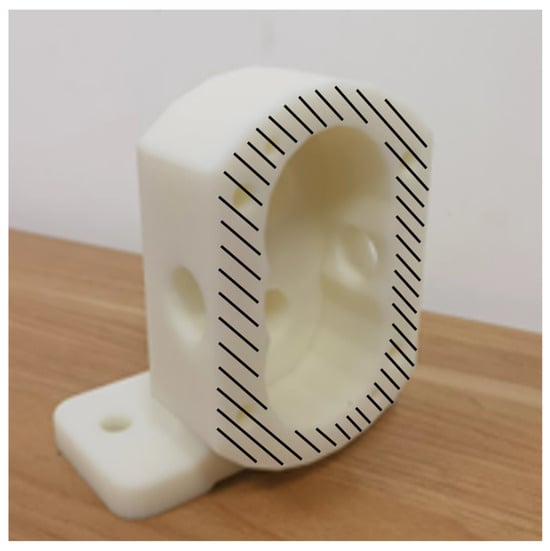
Figure 3.
The workpiece, a gear pump housing, a mock-up made of resin material.
The motion control program for the gantry milling machine is developed using the Siemens-provided software platform, i.e., TIA portal V18 [23], installed in the master computer. Communication between the master computer and the PLC is via the TCP/IP protocol, enabling the control program to be transferred to the PLC. Structured control language (SCL) is the main programming language for this axis motion control program, which also follows the PLCopen standard [24]. Figure 4 shows the program flow chart, indicating the following basic control functions for the three axes of the gantry milling machine:

Figure 4.
Method of control axis by PLC.
Home: executed before and after a set of tasks, ensuring the robot gripper is in its initial position (zero) before starting the next task.
Hand control mode: enables manual operation of the robot arm.
Automatic control mode: enables coordinated motor movement of the three axes for effective object handling.
3.3. The Virtual Twin
The virtual twin, as the virtual counterpart of the aforementioned physical twin, was developed based on Unity 3D [25], which basically includes digital twin (DT) models representing virtual models for the tangible process execution terminal with the gantry machine, and the workpiece. Continuous real-time data synchronization and amalgamation between the DT and the physical world were realized (to be discussed in Section 3), which enables our developed DT to simulate, monitor, and analyze the entirety of the process.
The virtual twin of our milling station, together with the workpiece, is shown in Figure 5. The relevant 3D models were created using PTC Creo [26] and saved as STEP format files, including the milling machine assembly, the gear pump housing, etc. We then used a Blender plugin (OCC Import) [27] to convert the STEP files to Blender format, which is further converted into FBX formatted files readable by Unity 3D (as it cannot directly read either STEP or Blender files). It is noted that conversions of file formats do result in loss of certain information, e.g., material properties, chemical compositions, etc. In addition, we also applied the merging of some model parts in the original machine assembly to simply the model in the virtual twin, thus reducing the computational load. Despite the simplification and the conversions made in the virtual twin modeling, we always pay special attention to retaining the key information essential to our modeling, such as motion pairs defining the relative motion of, e.g., lead-screw and nut, a key dimension of the workpiece.
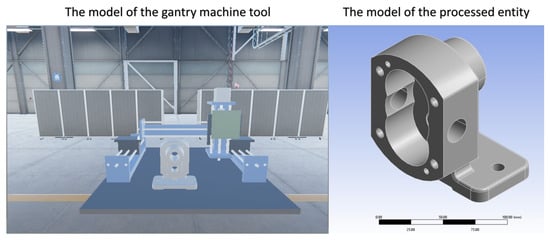
Figure 5.
The models of the gantry machine tool and processed entity.
3.4. Finite Element Modeling (FEM) of Milling Surface Deformation
A simulation computation terminal, based on ANSYS Workbench, was developed, which uses the finite element modeling (FEM) approach to simulate the machining processing under various work conditions, especially with different applied cutting force. The real-time process parameters that are vital to machining processing can be obtained, including strain and stress on the workpiece and cutting tool, etc.
To enable automatic execution of this simulation module, we applied a Python pip pyWbunit [28] using Python script, which defines all necessary model settings to automatically drive the computational model in ANSYS Workbench, instead of using ANSYS GUI for setting up and running the model manually. The flowchart of the simulation procedure, as defined with this Python script, is shown in Figure 6.
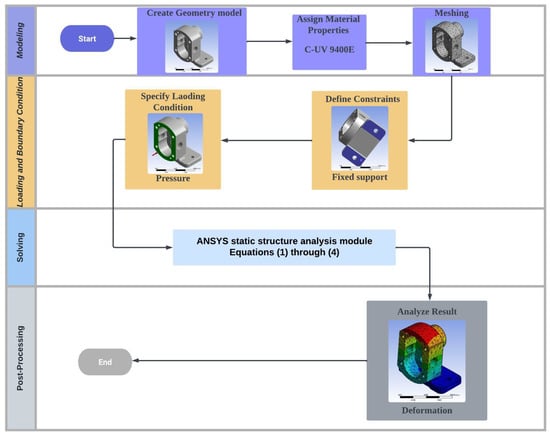
Figure 6.
The process of static structural analysis using ANSYS.
As for the mathematical model, we developed this based on ANSYS static structure analysis module, which is actually the static force model. This model is described as below:
- Elastic mechanics equation: Constitutive equation for linear elastic materials:where is stress, E is Young’s modulus (elastic modulus), and is strain.
- Equilibrium equation: Equilibrium equation:Here, is stress within the cross-sectional area A, and F represents the external forces acting on the structure.
- Displacement–force relationship: Displacement–force relationship for elastic bodies:where u is displacement, A is the cross-sectional area, E is Young’s modulus, and is stress.
- For elastic bodies, the relationship between strain and displacement can be expressed as follows:Here, is strain, and u, v, and w represent the displacements in the x, y, and z directions, respectively.
3.5. Data Collection and Transmission
The force sensor’s load feedback data are acquired by the PLC through the MODBUS RTU communication protocol. The motor parameters, on the other hand, are gathered via the built-in pulse generator of the PLC. Encoder data collection is executed with the high-speed counter integrated in the PLC. We developed necessary communication interfaces, by programming scripts in both C# and Python, to achieve real-time communication and data exchange in between the physical milling machine (the physical twin) and its DT counterpart (the virtual twin). Real-time retrieval of readings from the rotary encoder (with the machine axis motion parameters) and the force sensor (with the applied milling force), which are stored in the PLC, are first transferred to the database (Figure 1) of our virtual twin through TCP/IP communication protocol.
For motion control with the DT system, the database is accessed by Unity 3D, which finds rotary encoder readings to drive the virtual model of the milling machine (Figure 5) for a synchronous motion with its physical twin (Figure 2). Such data transmission is carried out through TCP/IP protocol, by adopting the S7Net plugin [29]. With S7Net, the C# script reads and writes data at specific PLC addresses, thus enabling data transmission. For preparation of such data transmission with S7Net, the Siemens TIA portal needs to configure the protection setting for full access and disable optimization access in every DB block used. The Visual Studio version 2015 and later must be used with Microsoft. Net Framework 4.5.2 and its higher version.
For FEM simulation, the ANSYS-based solver (Section 3.4) accesses the database to find the force sensor reads, i.e., the applied milling force, to drive the computation, obtaining real-time variation of stain and stress. Data transmission from the database to ANSYS Workbench is performed by applying Snap 7 [30], which is, again, based on TCP/IP protocol.
After Unity is launched, the communication script will attempt to establish a connection with the PLC. Upon successfully establishing the connection, the methods within the update loop will continuously search for data from designated offset addresses within the PLC. These addresses should be preconfigured to store data related to the gantry machine’s position in the database (DB) block. Subsequently, these data will be transmitted to the monitoring script of the virtual milling machine to regulate its real-time positional information.
Data from the UI panel, related to the virtual control of the physical system, is written to another pre-established offset address, and Figure 7 and Algorithm 1 show the UI panel design and pseudocode, respectively. These data include the user’s desired speed and direction for the machine’s movement. They are transmitted directly to the PLC’s motion control module, enabling the control of the machine’s movement through the PLC’s control panel, thereby achieving real control over the gantry machine tool. Furthermore, after switching the panel, it is possible to transfer “data regarding the direction and magnitude of force” to another offset address in the PLC. These data will be read and transmitted to ANSYS using Snap7 by a Python script, and, finally, ANSYS will complete the calculations. The data connectivity diagram is shown in Figure 8.
| Algorithm 1 UI Class Pseudocode |
|
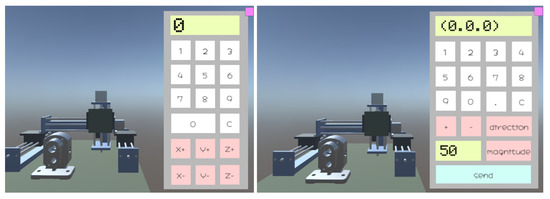
Figure 7.
UI interface.
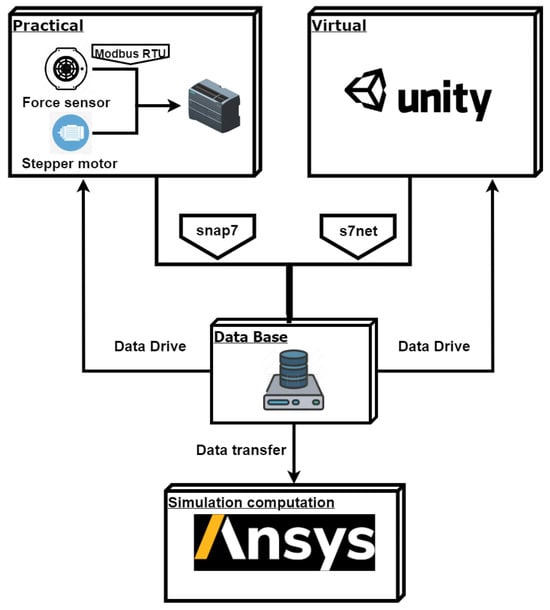
Figure 8.
Data connectivity for digital twin platforms.
3.6. DT Monitoring System
In our DT system, the control of the gantry machine tool can be managed by applying either a human–machine interface (HMI) or Unity 3D. During the operation of the milling machine, its control PLC continuously receives and transmits real-time data, which serves as a data conduit facilitating the establishment of a comprehensive mapping between the physical twin and the virtual twin involving the Unity 3D and ANSYS-based FEM solver. The flow of data exchange among various modules for both the physical twin (the gantry machine with rotary encoders, the force sensor, and the laser range finder) and the virtual twin (the virtual model in Unity 3D and the ANSYS-based FEM solver) is displayed in Figure 9. This enables effective real-time monitoring of the entire working procedure of this milling machine station, including real-time motion behavior and its accuracy, real-time applied milling force, the resulting simulated deformation variation with the accuracy of simulated results, etc.
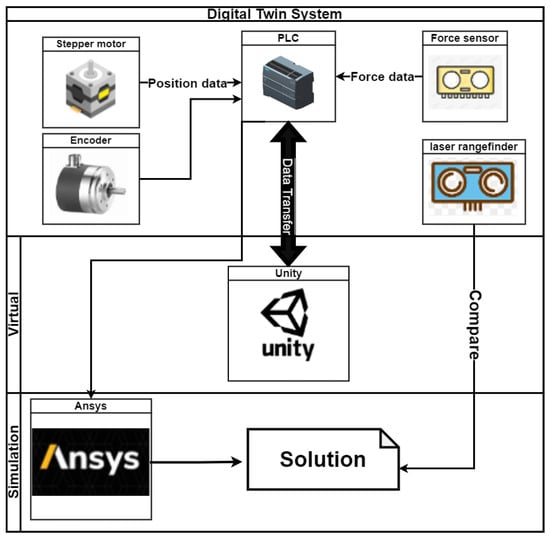
Figure 9.
The flow of communication and data transmission for our DT system.
The PLC, serving as a data conduit, is responsible for the continuous transmission of force-sensing data to ANSYS, a simulation software. These data, acquired during the machining process, are instrumental in the execution of mechanical simulation analyses within the ANSYS framework. The outcomes of these analyses are subsequently extracted as results, contributing deformation data of the processed entity.
For monitoring of motion precision and accuracy of each axis of the milling machine, for both the physical twin and the virtual twin, we use the rotary encoder readings as the reference. These readings are compared with expected motion parameters to ensure the motion accuracy of the physical machine being controlled by our DT system. On the other hand, these readings are compared with the motion parameters from the virtual machine in Unity 3D (Figure 5) to examine whether the physical twin and the virtual twin are seamlessly synchronized.
For monitoring of the real-time applied force, the force sensor readings are accessed by the PLC, which is then transmitted to our DT system through TCP/IP protocol.
For monitoring of the real-time deformation of the workpiece during the milling process, the applied milling force readings from the force sensor are accessed by the ANSYS-based FEM solver to obtain real-time stress and strain data of the workpiece. To further verify the accuracy of simulated results from our FEM solver, we use the laser range finder, which physically measures the actual deformation condition of the workpiece, i.e., the strain over the processed surface, in a real-time manner during the milling process. The readings are then stored in the PLC, which are, in turn, accessed by our DT system through TCP/IP protocol and compared with the simulated results. The flow of communication and data transmission of the system is shown in Figure 9 below.
4. Results and Discussion
4.1. The Control of Gantry Machine Tool
We now assess of the effectiveness of motion control through our developed DT, through a comparison of the two control methods available in our developed system, i.e., direct control using HMI and remote control via DT with the interface developed in Unity 3D.
4.1.1. Human–Machine Interface (HMI)
We used the Siemens HMI, model KTP700, which is directly compatible with the Siemens PLC. The control interface is shown in Figure 10 and enables manual control mode as well as automatic control with specified linear displacement for each axis. Data communication between HMI and PLC is achieved through ProfiNet, i.e., the Siemens-provided standard protocol that is highly efficient.
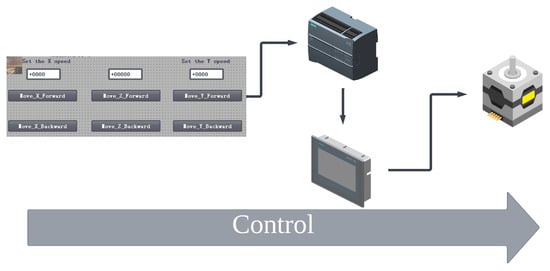
Figure 10.
SIMATIC HMI KTP700.
We tested the motion of the x axis, with the motor command displacement from one to six revolutions, and the actual rotational displacement of the axis measured by the rotary encoder is shown in Table 1, i.e., pulse number of encoder.

Table 1.
Comparison of motor rotation angle of the x axis, which is controlled by HMI and encoder pulse number.
4.1.2. UI Panel in Unity
We conducted the same, with the x axis, as that presented in Figure 11, while applying remote control with our developed DT, to assess the control efficiency in the context of both the response time and the motion accuracy.
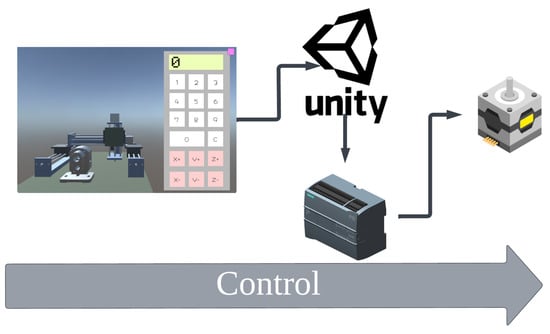
Figure 11.
Interface of UI panel in Unity.
With command displacements ranging from one to six revolutions, the encoder feedback is presented in Table 2, i.e., pulse number of encoder.

Table 2.
Comparison of motor rotation angle of the x axis, which is controlled by Unity 3D and encoder pulse number.
It is also noted that the delay time between command setting and axis motion cannot be discovered by visual observation, indicating a very quick response.
4.1.3. Monitoring and Error Detection
Through the TCP/IP communication protocol, we can simultaneously read data from the pulse generator and high-speed counter from the PLC. By using a pulse generator, the study can determine the number of revolutions of the stepper motor at each time point, while, by using a high-speed counter, it can determine how many pulses the stepper motor actually causes. Based on the 2 mm/rev lead of the screw, it is known that for each revolution, the load travels 2 mm on the screw, while the encoder counts 600 times in the high-speed counter. According to this law, the synchronization between reality and virtual reality can be evaluated by comparing the number of revolutions of the stepper motor with the data from the high-speed counter. The data of rotational displacement to the motor are obtained by reading the pulse generator of the PLC, while the encoder measurement is read by the PLC through the high-speed counter. The actual rotational displacement with both HMI and Unity-based control are presented in Table 1 and Table 2.
It can be seen that in the experiment conducted in this paper, there is a small error between the actual model and the virtual model. According to the conditions provided in this study, it can be judged that the DT system has qualified accuracy and reliability, regardless of it is controlled by HMI or Unity.
To demonstrate that the entire gantry machine tool maintains real-time mapping with the digital twin model during motion, we use the gantry machine tool to complete linear motion in space, as shown in Figure 12. After completing the motion, the x axis and y axis of the gantry machine tool will move five centimeters in the positive direction, and the z axis will move two centimeters in the positive direction. Based on the characteristics of each axis, we will know that any axis translation of 5 cm requires the motor to rotate 9000 turns, which means that the incremental encoder needs to generate 9000 × 600 pulse counts. Similarly, when any axis is shifted by 2 cm, the encoder generates 3600 × 600 pulses. The data collected are shown in Table 3.
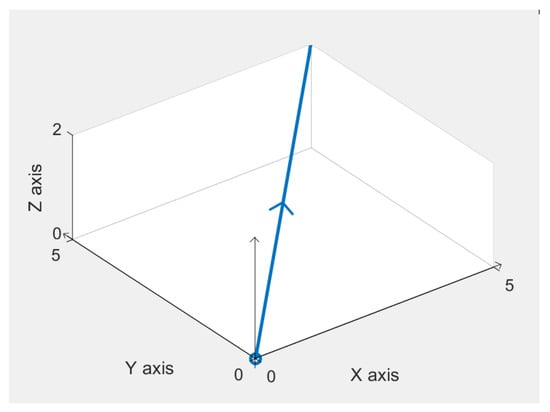
Figure 12.
The motion path of gantry machine tools.

Table 3.
Comparison of motor rotation angle of three axes and encoder pulse number.
From the table, the data indicate that in linear motion in space, the current digital twin (DT) system, utilizing machine tools driven by stepper motors, achieves a synchronization rate of 99 percent. This observation underscores the reliability of the DT model employed in the paper, particularly in its real-time monitoring functions.
4.2. Simulation Computation Solution
4.2.1. Data Initialization
The study uses ANSYS software for FEM analysis of the machining process, to calculate the real-time variation of deformation during the process. The study is based on the surface squeezing of the end face of the oil pump shell. Figure 13 shows the workpiece and the end surface which is to have pressure applied to it, while the material properties are presented in Figure 14.
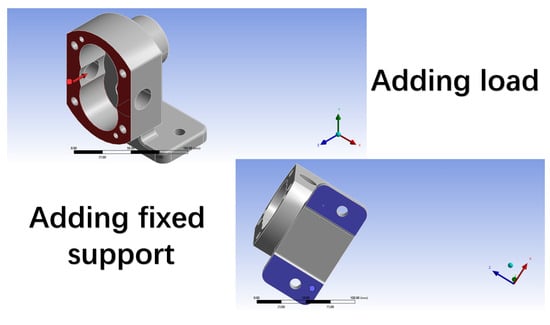
Figure 13.
Generate fixed supports and loads from script (note: in the experiment, we added loads in the same direction of the arrows in the diagram).
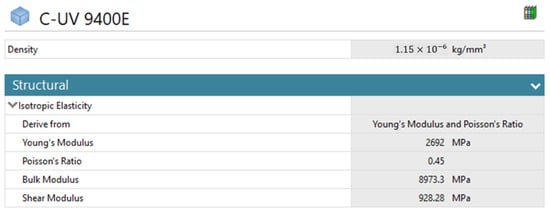
Figure 14.
Generate material data from scripts.
The computation is initialized by using a Python script that chooses the static structure analysis system and defines the key parameters of the machining process to be assessed, including material property data of Figure 14, as well as defining the location where either supports or loads are applied, as shown in Figure 13.
4.2.2. Finite Element Analysis Results
In practical scenarios, industrial loads may extend into the magnitudes of thousands, or even tens of thousands, of Newtons. However, constrained by experimental conditions, we deliberately confined our investigation to the range of applied loads between 500 N and 750 N, increasing in 50 N increments. With finite element analysis, we can obtain the deformation, S, generated by the processed entity in the current situation which is under different loads, F, as shown in Figure 15. At the same time, the deformation data measured by the laser rangefinder are obtained to compare with deformation S, so that the study can assess the accuracy of our FEM simulation through such comparison, shown in Figure 16. Following the execution of finite element analysis, the maximum deformation of the subject entity was ascertained under six distinct loads. Subsequently, a laser rangefinder was deployed to gauge the displacement data of the central point within the red area in the post-deformation rendering, capturing the deformation value of the entity under these six varied loads. Notably, four measurements were conducted for each specific load magnitude. The ensuing line chart delineates a comparative analysis between the physical deformation data derived from ANSYS through four measurements and the deformation data acquired via a laser measuring instrument.
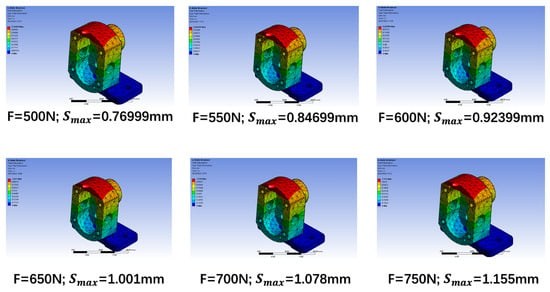
Figure 15.
Deformation of the processed entity.
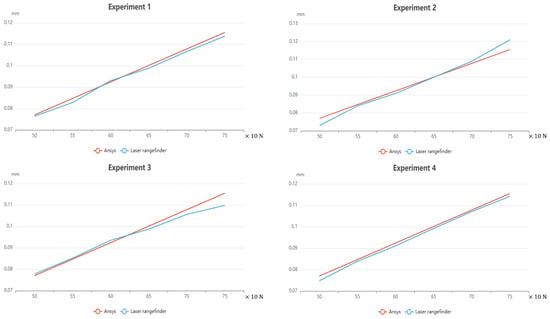
Figure 16.
A comparison between simulation and measured results on the milling surface: the maximum deformation variation as a function of applied force.
The comparison between the computational and experimental outcomes validates the accuracy of our model in predicting deformation under loads ranging from 500 N to 750 N. With real-time display, in our DT system, the deformation on the processed surface and real-time monitoring of the machining processing can be effectively realized, which can guide the optimization of the machining process.
5. Limitations and Future Work
While a substantial portion of the anticipated tasks were successfully executed, certain facets of the work fell short of expectations. Due to the extant hardware facilities and budgetary limitations, the instrumentation employed in this study falls short of industrial-grade standards. Despite the experimental results substantiating the commendable accuracy and reliability of the investigation, it is essential to acknowledge the existing disparity between the utilized equipment, experimental conditions, and the benchmarks set by industrial standards. Specifically, the force sensors, laser rangefinders, and processing machine tools utilized in this study fall short of conformity with prevailing industry standards. This noncompliance introduces the prospect of data inaccuracy and constitutes a potential source of interference in subsequent calculations. Consequently, the overall accuracy of the study is diminished. The current system encounters challenges in attaining comprehensive synchronization during the monitoring of processed entities as well. As highlighted by Yong Liang [31], the utilization of finite element mechanics simulation for physical modeling in ANSYS is accompanied by protracted solution times and an accumulation of voluminous data during the solving process. This arises from the inherent complexity of the model and the expansive scale of the problem under consideration. Such computational intricacies pose a potential impediment to maintaining optimal synchronization rates in the monitoring process and can impact the clarity and accuracy of the final simulation results. Addressing these challenges necessitates a judicious approach involving the simplification of the finite element model, thereby presenting a formidable technical undertaking that demands careful consideration and adept resolution.The occurrence of these limitations is poised to significantly impede the synchronization rate of the digital twin (DT) system. In the context of any digital twin system, the degradation of a high synchronization rate bears substantial ramifications on the efficacy of system monitoring and control. Such a scenario has the potential to introduce errors into the user’s assessment of the system, thereby diminishing factory capacity, work efficiency, and precipitating unwarranted costs.
In terms of simulating in Unity, one regrettable aspect of this research is the inability to receive and synchronize data from ANSYS. This means that the digital twin model in Unity cannot accurately reflect the deformations of the real-time compressed model. Currently, we can directly input the direction and magnitude of the applied force in Unity, and the data are then transferred to ANSYS via PLC to obtain results. However, ANSYS currently supports exporting model results only in the form of displacement data for various nodes, and it can only export data in TXT format. Additionally, to maintain real-time performance, it is necessary to calculate the current deformation and output it in TXT format every few seconds. Although it is possible to read string data from the TXT files using C#, most models have over ten thousand nodes, and remodeling in Unity based on the data of changes in the position of each node causes unacceptable delays. Considering that the actual deformations of objects are very subtle and not clearly visible in Unity, we have, therefore, only established one-way communication from Unity to ANSYS.
In the second phase of the research, we will attempt to increase the budget and use more accurate sensors and measuring instruments to ensure the accuracy of the experimental results. In addition, there lies an opportunity to streamline finite element models by conscientiously simplifying the models. This involves a judicious reduction in the number of nodes and elements, thereby mitigating computational intricacies. The aim is to eliminate extraneous geometric details without compromising result accuracy. An additional avenue for enhancing computational efficiency involves grid optimization, where adjustments to grid density and structure are made to curtail computational time. Parallel computing stands out as a viable strategy. Leveraging computer clusters or multicore processors can substantially expedite the solution process. Moreover, the migration of computations to higher-performance computing environments or cloud platforms presents a promising prospect for augmenting computational speed [31]. This holistic approach, encompassing both model simplification and computational optimization, holds the promise of enhancing the overall efficiency of the whole system.
6. Conclusions
The present study made an attempt to develop an intelligent manufacturing digital twin (DT) system for a typical machining process (i.e., the milling operation), which includes integrated visualization technologies and an integrated computer simulation model based on finite element modeling (FEM) for obtaining real-time process parameters. Our developed DT system can achieve real-time monitoring and control of coordinated motion of multiaxes of the machine tool, through seamless synchronization of control commands/virtual machine motion from the virtual twin (the DT model in Unity 3D) and the physical twin (the actual milling machine). More importantly, our DT system facilitated the visual representation of microstructural data variations, by obtaining and displaying FEM simulated results of real-time strain and stress variations of the workpiece and its machined surface, which can further be used for real-time control and optimization of machining processes. Consequently, real-time adjustments to machine tool orientation during the processing project can be executed, mitigating collision risks and enabling accurate prognostication of the processing cycle. An inherent advantage of this proposed scheme lies in the broadened scope of monitoring, encompassing not only the surveillance of the processing machinery but also extending to the condition detection of the processed product. Through vigilant monitoring of the product status, the product’s quality control capabilities are significantly enhanced, obviating the economic and temporal costs associated with traditional manual process optimization. This, in turn, substantially amplifies operational efficiency within the manufacturing environment. The outcomes of this research are poised to effectively diminish the risks and costs associated with processing, thereby instilling the benefits of comprehensive, automated, and precision-based processing. This research stands as a valuable ally to manufacturing enterprises, markedly reducing trial and error costs, minimizing processing errors, elevating processing efficiency, and facilitating comprehensive process management and optimization. As Grieves et al. [2] reported, the capacity to create, test, produce, and operate virtualized copies of systems is the idea behind digital twins. It can assist us in determining whether our concept is actually feasible to produce and identify the fault mode when the system is operating. This approach has the potential to mitigate physical system failures during deployment and operation, save expenses and time, and, most significantly, protect users from damage. Furthermore, this study anticipates achieving judicious production scheduling, maximizing equipment efficiency, curbing material consumption, and addressing environmental concerns through the reduction of waste emissions, thereby fostering a paradigm of green, energy-efficient, and environmentally sustainable production.
Extensive experiments and results obtained (as discussed in Section 4) can readily show that our developed DT system has satisfactory performance in the context of communication efficiency, control accuracy, and efficient monitoring of the machine process. Firstly, it can achieve dual-directional data communication between the physical twin and virtual twin with high efficiency, as shown by the available results of both the physical milling station and its virtual model, as well as displayed motion parameters in the UI interface, in Unity 3D it can synchronize seamlessly. Secondly, available results show that, by controlling the milling machine with our DT system from UI interface in Unity 3D, the actual motion of each axis shows very small deviation as compared with the respective command motion parameters, indicating high accuracy using our developed DT-based control approach. Finally, we integrated an ANSYS-based FEM solver for real-time access and monitoring of deformation variation of the workpiece during the milling process, the data of which are proven to be accurate by comparing with relevant measured data, thus enabling real-time monitoring of machining process parameters. While the present study demonstrated satisfactory performance in both control and monitoring of a typical milling machining process, our developed DT system still has limitations due to various constraints in terms of budget, space, and university/department policy, which renders our work having a considerable gap from the real industrial scenario, such as sensoring precision, calculation accuracy, the realness of machining process, etc. Future work will try to solve these problems, aiming to recover a far more realistic industrial scenario, hence enabling further verification of our proposed approach. Furthermore, we still face challenges in comprehensive synchronization during entity monitoring arising due to computational intricacies in FEM-simulation-based work in ANSYS.
To address this gap, future efforts will focus on the simplification of our FE model and enhancement of computational efficiency by streamlining FE models through node and element reduction, along with grid optimization and parallel computing. The proposed approach holds the potential to improve the overall efficiency of the digital twin system for intelligent manufacturing applications in future iterations.
Author Contributions
Conceptualization, H.W., Q.Z. and Q.S.; Methodology, H.W. and Z.Y.; Software, H.W. and Z.Y.; Validation, H.W. and Z.Y.; Formal analysis, H.W. and Z.Y.; Investigation, H.W. and Z.Y.; Writing—original draft, H.W. and Z.Y.; Writing—review & editing, Q.Z. and Q.S.; Supervision, Q.Z. and Q.S.; Project administration, Q.Z. and Q.S.; Funding acquisition, Q.S. and E.L. All authors have read and agreed to the published version of the manuscript.
Funding
This work is supported by the XJTLU AI University Research Centre, Jiangsu Province Engineering Research Centre of Data Science and Cognitive Computation at XJTLU, SIP AI innovation platform (YZCXPT2022103) and the Suzhou Municipal Key Laboratory for Intelligent Virtual Engineering (SZS2022004).
Data Availability Statement
The data can be shared up on request.
Conflicts of Interest
The authors declare no conflict of interest.
References
- Liu, D.-T.; Guo, K.; Wang, B.-K.; Peng, Y. Summary and perspective survey on digital twin technology. Chin. J. Sci. Instrum. 2018, 39, 1–10. [Google Scholar] [CrossRef]
- Grieves, M.; Vickers, J. Digital Twin: Mitigating Unpredictable, Undesirable Emergent Behavior in Complex Systems. In Transdisciplinary Perspectives on Complex Systems; Kahlen, J., Flumerfelt, S., Alves, A., Eds.; Springer: Cham, Swizterland, 2017. [Google Scholar] [CrossRef]
- Yu, Y.; Hu, D.Y.; Dai, S.; Zhao, J. Digital Twin Applications in Process Design. J. Aerosp. Manuf. Technol. 2018, 61, 26–33. [Google Scholar] [CrossRef]
- Guo, F.Y.; Liu, J.H.; Zou, F.; Zhai, Y.N.; Wang, Z.Q.; Li, J. Current Status and Key Implementation Technologies of Digital Twin-Driven Assembly Process Design. J. Mech. Eng. 2020, 55, 110–132. [Google Scholar] [CrossRef]
- Tao, F.; Cheng, Y.; Cheng, J.F.; Zhang, M.; Xu, W.J.; Qi, J. Information-Physical Fusion Theory and Technology for Digital Twin Workshop. J. Comput. Integr. Manuf. Syst. 2017, 23, 1603. [Google Scholar] [CrossRef]
- Balla, M.; Haffner, O.; Kučera, E.; Cigánek, J. Educational Case Studies: Creating a Digital Twin of the Production Line in TIA Portal, Unity, and Game4Automation Framework. Sensors 2023, 23, 4977. [Google Scholar] [CrossRef] [PubMed]
- Yang, C.; Tu, X.; Autiosalo, J.; Ala-Laurinaho, R.; Mattila, J.; Salminen, P.; Tammi, K. Extended Reality Application Framework for a Digital-Twin-Based Smart Crane. Appl. Sci. 2022, 12, 6030. [Google Scholar] [CrossRef]
- OPC UA. Unified Architecture—OPC Foundation. Available online: https://opcfoundation.org/about/opc-technologies/opc-ua/ (accessed on 23 January 2024).
- Mincă, E.; Filipescu, A.; Cernega, D.; Șolea, R.; Filipescu, A.; Ionescu, D.; Simion, G. Digital Twin for a Multifunctional Technology of Flexible Assembly on a Mechatronics Line with Integrated Robotic Systems and Mobile Visual Sensor—Challenges towards Industry 5.0. Sensors 2022, 22, 8153. [Google Scholar] [CrossRef] [PubMed]
- Garg, G.; Kuts, V.; Anbarjafari, G. Digital Twin for FANUC Robots: Industrial Robot Programming and Simulation Using Virtual Reality. Sustainability 2021, 13, 10336. [Google Scholar] [CrossRef]
- Wang, W.; Ding, W.; Hua, C.; Zhang, H.; Feng, H.; Yao, Y. A Digital Twin for 3D Path Planning of Large-Span Curved-Arm Gantry Robot. Robot. Comput.-Integr. Manuf. 2022, 76, 102330. [Google Scholar] [CrossRef]
- Halenar, I.; Juhas, M.; Juhasova, B.; Borkin, D. Virtualization of Production Using Digital Twin Technology. In Proceedings of the 2019 20th International Carpathian Control Conference (ICCC), Kraków, Poland, 26–29 May 2019; pp. 1–5. [Google Scholar]
- AVEVA Wonderware. Available online: https://www.aveva.com/en/solutions/operations/wonderware/ (accessed on 23 January 2024).
- Fallaha, M.; Korhan, O.; Zeeshan, Q. Virtual reality: A possibility for training operator 4.0. In Proceedings of the Industrial Engineering in the Internet-of-Things World, San Diego, CA, USA, 17–18 March 2022; Calisir, F., Ed.; Springer International Publishing: Cham, Switzerland, 2022; pp. 335–347. [Google Scholar]
- Thürer, M.; Li, S.S.; Qu, T. Digital Twin Architecture for Production Logistics: The Critical Role of Programmable Logic Controllers (PLCs). Procedia Comput. Sci. 2022, 200, 710–717. [Google Scholar] [CrossRef]
- Hauge, J.B.; Zafarzadeh, M.; Jeong, Y.; Li, Y.; Khilji, W.A.; Wiktorsson, M. Employing digital twins within production logistics. In Proceedings of the 2020 IEEE International Conference on Engineering, Technology and Innovation (ICE/ITMC), Cardiff, UK, 15–17 June 2020; pp. 1–8. [Google Scholar]
- Židek, K.; Piteľ, J.; Adámek, M.; Lazorík, P.; Hošovský, A. Digital Twin of Experimental Smart Manufacturing Assembly System for Industry 4.0 Concept. Sustainability 2020, 12, 3658. [Google Scholar] [CrossRef]
- Lai, X.; Wang, S.; Guo, Z.; Zhang, C.; Sun, W.; Song, X. Designing a Shape—Performance Integrated Digital Twin Based on Multiple Models and Dynamic Data: A Boom Crane Example. J. Mech. Des. 2021, 143, 071703. [Google Scholar] [CrossRef]
- ANSYS WORKBENCH. Available online: https://www.ansys.com/products/ansys-workbench (accessed on 23 January 2024).
- Anh, T.T.; Tan, N.T.; Le, D.T.; Hieu, L.C.; Mahmud, J.; Latif, M.J.; Quang, N.H. Digital Twins of Robotic Systems: Increasing Capability for Industrial Applications. In Machine Learning and Mechanics Based Soft Computing Applications; Nguyen, T.D.L., Lu, J., Eds.; Studies in Computational Intelligence; Springer: Singapore, 2023; Volume 1068. [Google Scholar] [CrossRef]
- Cheypoca, T.; Luanpol, A.; Wuti, V. Circular Interpolation using Siemens S7-1200. In Proceedings of the 9th International Conference on Engineering, Applied Sciences, and Technology (ICEAST), Vientiane, Laos, 1–4 June 2023; pp. 1–4. [Google Scholar] [CrossRef]
- Product Overview for SIMATIC S7-1200. Available online: https://www.siemens.com/globa-l/en/products/automation/systems/industrial/plc/s7-1200.html (accessed on 23 January 2024).
- TIA Portal V18. Available online: https://assets.new.siemens.com/siemens/assets/api/uuid:36774439-e6a7-4fd4-bd07-feb8abe261d4/julewebinar-tia-v18-hardware-web.pdf (accessed on 23 January 2024).
- PLCopen Standard. Motion Control | PLCopen. Available online: https://www.plcopen.org/technical-activities/motion-control#:~:text=The%20PLCopen%20motion%20standard%20provides%20a%20way%20to,decrease%2C%20and%20the%20software%20is%20reusable%20across%20platforms (accessed on 23 January 2024).
- Unity 3D. Available online: https://unity.com/cn (accessed on 23 January 2024).
- PTC Creo. Creo CAD Software: Enable the Latest in Design | PTC. Available online: https://www.ptc.com/en/products/creo (accessed on 23 January 2024).
- Blender plugin (OCC Import). blender.org—Home of the Blender Project—Free and Open 3D Creation Software. Available online: https://www.blender.org/ (accessed on 23 January 2024).
- ANSYS PyWbUnit. Available online: https://github.com/ansys-dev/PyWbUnit/blob/develop (accessed on 23 January 2024).
- Croes, M. s7netplus. Available online: https://github.com/S7NetPlus/s7netplus (accessed on 24 October 2023).
- Python python-snap7. Available online: https://pypi.org/project/python-snap7/ (accessed on 24 October 2023).
- Liang, Y.; Wang, X.; Jiang, X.; Che, L.; Wang, D. Research on real-time monitoring technology of continuous ship unloader based on digital twin. Machinery 2022, 49, 67–72. [Google Scholar] [CrossRef]
Disclaimer/Publisher’s Note: The statements, opinions and data contained in all publications are solely those of the individual author(s) and contributor(s) and not of MDPI and/or the editor(s). MDPI and/or the editor(s) disclaim responsibility for any injury to people or property resulting from any ideas, methods, instructions or products referred to in the content. |
© 2024 by the authors. Licensee MDPI, Basel, Switzerland. This article is an open access article distributed under the terms and conditions of the Creative Commons Attribution (CC BY) license (https://creativecommons.org/licenses/by/4.0/).